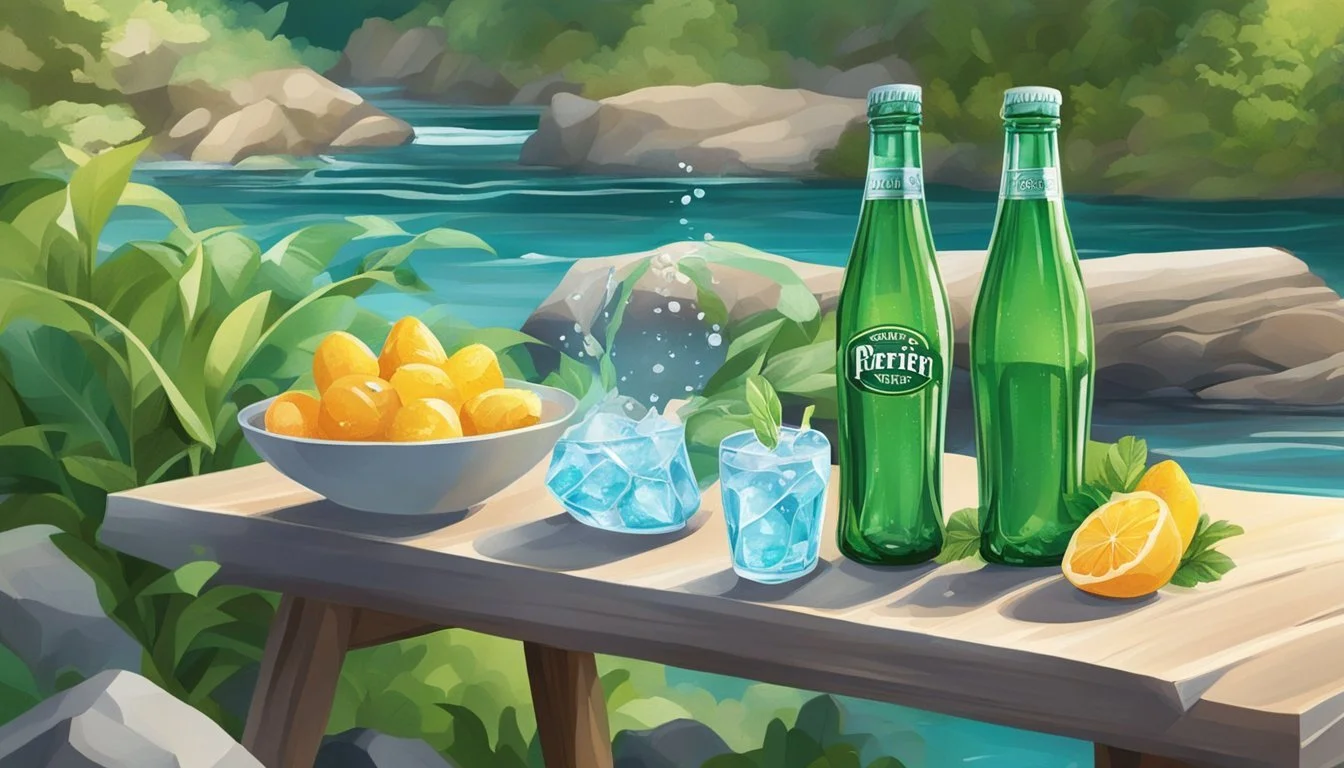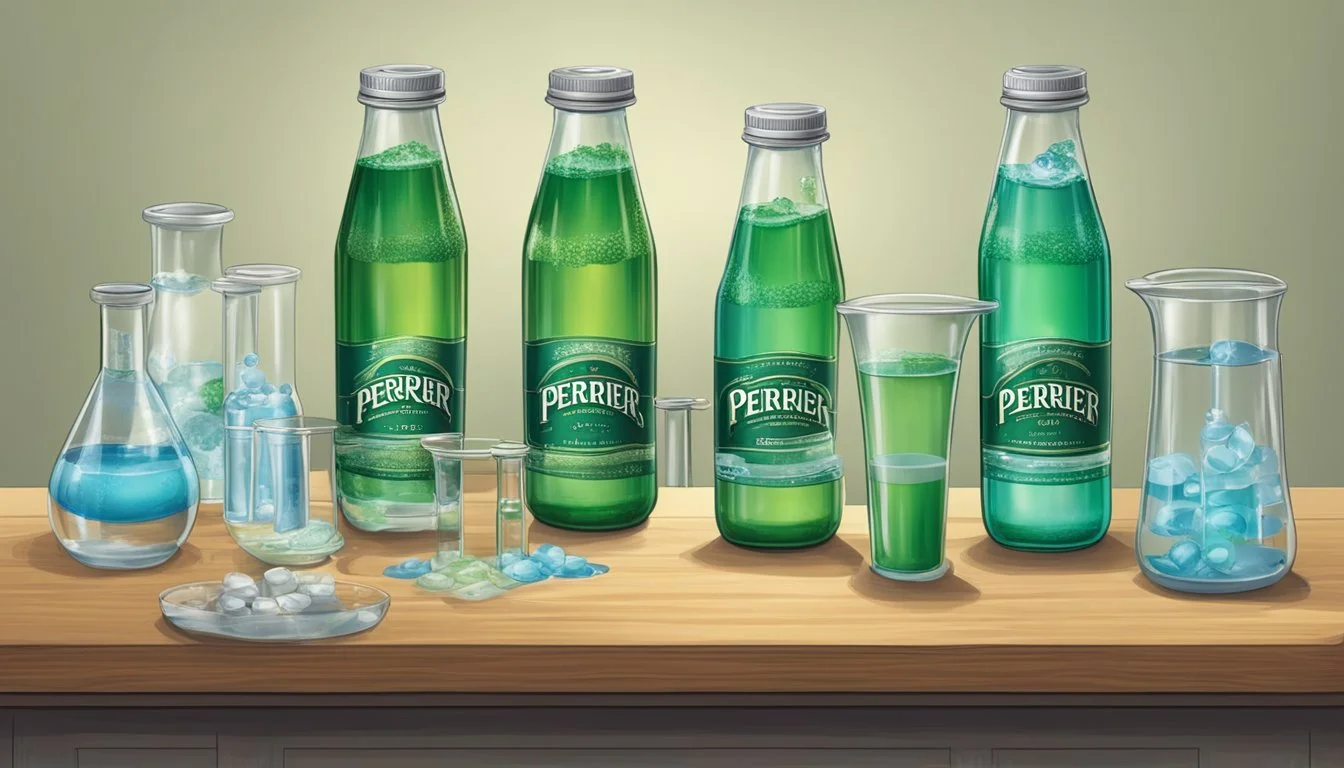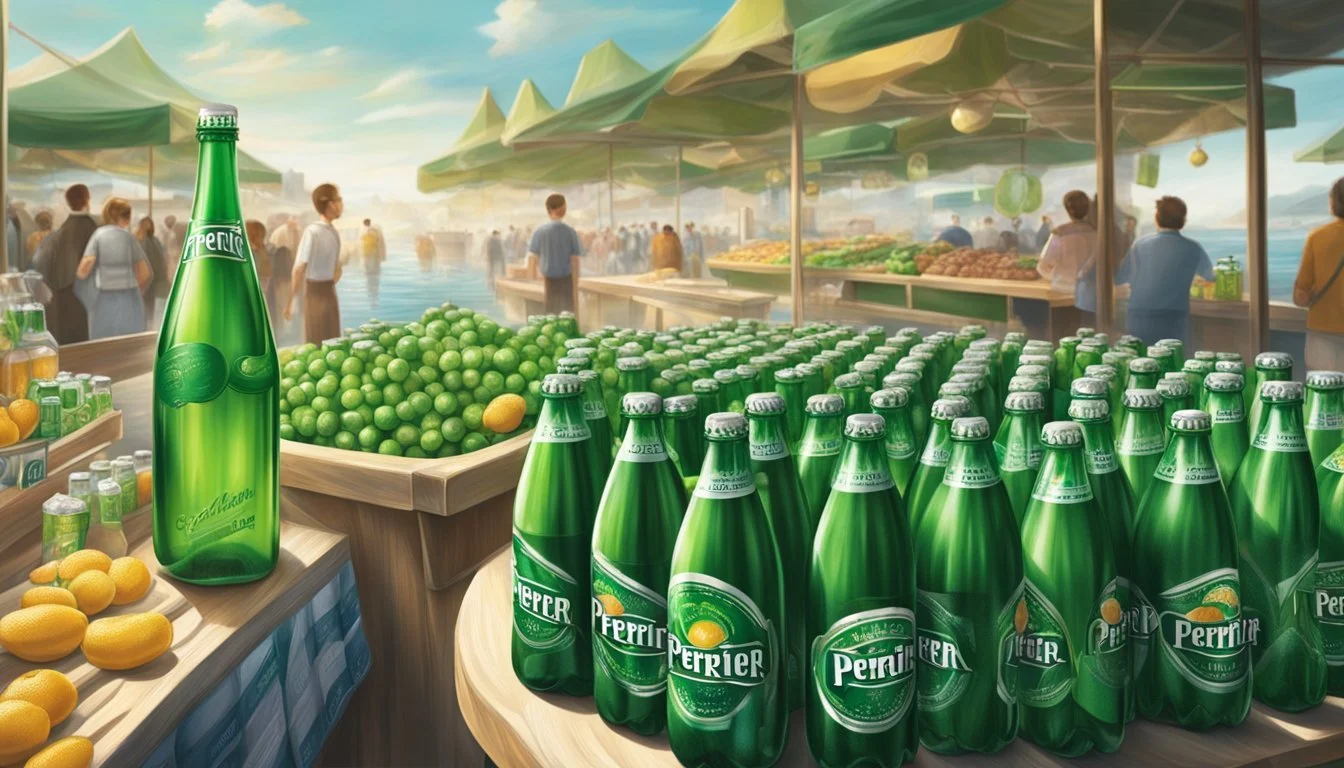Perrier vs. Open Water
A Comparative Bottled Water Analysis
For many people, choosing between Perrier and Open Water can be a blend of taste preferences, health considerations, and environmental consciousness. Perrier, renowned for its sparkling mineral water, offers a unique effervescence and a rich mineral blend that appeals to a refined palate. On the other hand, Open Water is gaining traction due to its commitment to sustainability, boasting packaging that aims to reduce plastic waste through recyclable aluminum bottles.
When comparing taste, Perrier's distinct, fizzy experience contrasts sharply with the stillness of Open Water, catering to those who prefer their hydration a bit more sophisticated. While Perrier attracts consumers looking for a classic, carbonated option, Open Water appeals to the eco-conscious with its clean, straightforward hydration and environmentally friendly packaging.
Nutritional differences further distinguish these two brands. Perrier contains natural minerals that may add a slight health benefit, whereas Open Water offers pure hydration without additives. The choice ultimately hinges on whether taste and mineral content or environmental values and simplicity are more important to the consumer.
Origins and Source of Bottled Water
Understanding the roots and processes behind Perrier and Open Water reveals much about their distinguished qualities. Both brands have unique origins and sourcing techniques that contribute to their distinct characteristics.
History of Perrier
Perrier, an iconic brand of sparkling mineral water, traces its origins to the town of Vergèze in France. This brand became officially recognized in 1863. Historical tales suggest Hannibal may have visited Vergèze during his march to Rome in 218 BC.
Dr. Louis Perrier started commercial operations in 1894, leveraging the town’s natural spring. By 1898, Perrier was well on its way to becoming the "champagne of table waters". Its distinctive green bottle and carbonation set it apart, building an enduring legacy.
History of Open Water
Open Water, a newer brand compared to Perrier, focuses on sustainability and eco-friendliness. Founded in the 2010s, it aims to provide a low-carbon footprint alternative in the bottled water industry.
It sources its water from carefully selected natural springs, ensuring optimal purity and taste. The brand packages its water in recyclable aluminum bottles, reducing plastic waste significantly. Open Water is dedicated to environmental responsibility, making it a modern choice for conscientious consumers.
Sourcing Techniques
Perrier's water comes from natural springs in Vergèze, France. The water undergoes a carbonation process directly at the source, capturing its iconic effervescence. The unique mineral composition is achieved through natural filtration, enhancing its fresh and clean taste.
Open Water uses advanced sourcing techniques, selecting high-quality natural springs across various locations. They ensure the water remains pure by meticulously managing the springs and surrounding environment. Their focus on sustainability means their processing and packaging methods prioritize reducing carbon emissions and waste.
By understanding the origins and sourcing behind Perrier and Open Water, consumers can better appreciate the unique qualities each brand brings to the table.
Chemical Composition and Mineral Content
When comparing Perrier and Open Water, it's important to evaluate the chemical composition and mineral content of each. This analysis will help determine their nutritional value and suitability based on individual needs and preferences.
Perrier Mineral Profile
Perrier is well-known for its distinctive bubbles and unique taste, which stem from its mineral content. Naturally carbonated, Perrier contains a significant amount of calcium, magnesium, and potassium.
Calcium: Approximately 160 mg/L
Magnesium: Around 4.8 mg/L
Potassium: Near 1 mg/L
The bicarbonate levels in Perrier are substantial, contributing to its alkaline nature. With a mineral water classification, Perrier also has trace amounts of iron, which may be beneficial for some consumers.
Open Water Nutrient Analysis
Open Water, typically derived from purified sources, differs in mineral content compared to natural mineral waters like Perrier. It undergoes extensive purification processes that often result in minimal mineral presence.
Calcium: Low levels, less than 10 mg/L
Magnesium: Very minimal, often below 1 mg/L
Potassium: Negligible amounts
Open Water is primarily known for being free of contaminants and additives, featuring a neutral taste and clean profile. The focus is less on minerals and more on purity, ensuring no added substances like bicarbonates or iron.
Comparison of Mineral Content
When comparing Perrier to Open Water, the mineral differences are clear. Perrier offers a rich mineral composition beneficial for those looking to supplement their diet with calcium and magnesium.
Mineral Perrier Open Water Calcium 160 mg/L <10 mg/L Magnesium 4.8 mg/L <1 mg/L Potassium 1 mg/L Negligible Bicarbonate High None Iron Trace amounts None
Perrier's high bicarbonate content may help those who prefer an alkaline beverage. In contrast, Open Water appeals to those who prioritize purity and minimalistic ingredient profiles.
Health and Hydration
Choosing between Perrier and Open Water involves assessing factors like hydration potential, mineral content, and electrolyte balance. Each type of water has unique qualities that impact health and wellness.
Hydration and Body Health
Hydration is crucial for bodily functions such as maintaining temperature, lubricating joints, and transporting nutrients. Perrier comes from natural springs and is carbonated, enhancing the drinking experience for some. Open Water, in contrast, often emphasizes sustainability with its eco-friendly packaging. Both waters effectively contribute to daily hydration needs, but individual preferences for carbonation and environmental impact might influence choice.
Impact of Minerals on Health
Perrier is naturally rich in minerals such as calcium, magnesium, and bicarbonates, which support bone health and muscle function. Increased mineral content can positively influence the body's pH levels, aiding in maintaining alkalinity. Open Water, often purified, might lack these natural minerals but can be enhanced artificially to provide similar benefits. Assessing the presence and type of minerals is key for those prioritizing mineral intake.
Balancing Electrolytes
Electrolytes are essential for regulating muscle function, heart rhythm, and fluid balance. Perrier's natural mineral composition includes valuable electrolytes, promoting effective hydration and electrolyte balance. Open Water might undergo purification processes that potentially strip away natural electrolytes. Some brands might add electrolytes back into the water to achieve desired health benefits. It's crucial to check labels for electrolyte content to ensure balanced hydration, especially in active lifestyles or hot climates.
Taste and Carbonation
Perrier and Open Water offer distinct experiences due to their differences in taste and carbonation. Each has its unique flavor profile and levels of effervescence, catering to varying preferences.
Taste Profile of Perrier
Perrier is renowned for its crisp, clean taste, sourced from a natural spring in Vergeze, France. Its taste is infused with minerals that impart a subtle yet noticeable flavor. This sparkling mineral water has a balanced profile, offering a refreshing mouthfeel without overwhelming the palate. The carbonation in Perrier is naturally occurring, which results in gentle and consistent bubbles. The distinct mineral taste can sometimes be described as slightly salty, depending on individual preference.
Taste Profile of Open Water
Open Water, on the other hand, provides a different experience. This brand is known for its neutral and pure taste, primarily because it is sourced from isolated, pristine locations. Open Water is typically marketed as still water, meaning it lacks carbonation, offering a smooth and clean flavor profile. The absence of carbonation ensures that there is no tanginess or acidity, making it ideal for those who prefer a straightforward water taste without mineral aftertastes or bubbles.
The Role of Carbonation
Carbonation plays a significant role in the drinking experience, particularly for those choosing between sparkling and still water. Perrier's signature bubbles are a result of natural carbon dioxide integration, which enhances the sensation of freshness and provides a sparkling mouthfeel. In contrast, Open Water lacks any carbonation, making it an optimal choice for pure hydration without the fizzy sensation. The presence or absence of carbonation can significantly influence taste, mouthfeel, and personal preference.
These factors make Perrier and Open Water suitable for distinct occasions and preferences, with Perrier appealing to those who enjoy the tingle of bubbles and a slightly mineral-rich flavor, while Open Water caters to individuals seeking pure, still refreshment.
Price Comparison and Value
When choosing between Perrier and Open Water, cost and value are significant factors. This analysis will cover the price points and the overall value each water brand brings to the market.
Cost Analysis of Perrier
Perrier is generally priced higher compared to many other bottled water brands.
For a 500ml bottle, the price typically ranges from $1.50 to $2.00. Perrier's position as a premium sparkling mineral water contributes to its higher price point.
Perrier has a significant market share in the sparkling water category. In 2019, it held 9.2% of the market, with nearly $300 million in sales.
It's often viewed as a luxury brand, which can justify its higher cost. Despite its price, Perrier's distinctive taste and mineral content offer notable value for those seeking premium hydration.
Cost Analysis of Open Water
Open Water, a brand focused on sustainability, markets itself as an eco-friendly option.
The price for a 500ml bottle of Open Water generally falls between $1.00 to $1.50. Its competitive pricing makes it an attractive choice for environmentally conscious consumers.
Open Water is packaged in recyclable aluminum bottles, which is a key selling point. This brand has positioned itself within a growing market of eco-friendly products, appealing to those prioritizing sustainability without a significant price premium.
Open Water delivers a balance of modest cost and environmental responsibility, making it a valuable option for specific market segments.
Value for Money
When evaluating value for money, it's essential to consider both price and what each brand offers.
Perrier offers a premium experience with its sparkling mineral water, distinguished taste, and strong market presence. Its higher price point reflects its luxury positioning and the value is in the quality and brand prestige.
Open Water, on the other hand, balances cost with environmental sustainability. Priced lower than Perrier, it targets consumers who value eco-friendly practices.
While it may not offer the same luxury feel as Perrier, its value lies in sustainability and competitive pricing, making it a smart choice for environmentally conscious buyers.
Market Presence and Brand Reputation
Perrier and Open Water are two distinct brands that cater to different consumer preferences in the bottled water market. This section explores their global reach, market strategies, and consumer preferences.
Perrier's Global Reach
Perrier, a brand under Nestlé Waters, has an extensive international presence. It is renowned for its sparkling mineral water, often associated with luxury and sophistication.
Perrier's distinctive green bottle is a recognizable symbol, making it a staple in upscale restaurants and boutiques worldwide. Its marketing often targets health-conscious and affluent consumers, which reinforces its premium image.
The brand's global distribution network and high visibility in various markets have helped maintain its strong market position. Perrier continually adapts to regional tastes and preferences, ensuring a wide consumer base across different geographies.
Open Water's Market Strategy
Open Water, a younger brand, positions itself as a sustainable alternative in the bottled water industry. Emphasizing eco-friendly packaging, the brand aims to reduce plastic waste by utilizing recyclable aluminum bottles.
Open Water's marketing campaigns highlight their commitment to environmental sustainability, appealing to environmentally conscious consumers. The brand targets a demographic that prioritizes ethical consumption and environmental responsibility.
Their distribution is more concentrated than Perrier’s but is growing, particularly in urban areas and health-centric retailers. This strategy allows them to carve out a niche in the competitive bottled water market by appealing to a specific segment.
Consumer Preferences and Trends
Consumer preferences in bottled water have shifted towards both premium quality and environmental sustainability. Brands like Perrier benefit from a reputation for high-quality, mineral-rich water, appealing to those who seek a sophisticated choice.
Conversely, Open Water attracts consumers who are motivated by ecological impact and are willing to support sustainable products.
Current market trends indicate a growing demand for both sparkling and sustainably packaged water. As a result, brands that can effectively communicate their unique value propositions are likely to succeed. Combining quality with ethical considerations is increasingly important.
Regulatory Compliance and Safety Standards
Ensuring the safety and quality of bottled water involves stringent regulatory compliance. Key aspects of this evaluation include quality control during production and alignment with both EPA and international standards.
Quality Control in Production
Perrier and Open Water implement rigorous quality control measures to meet safety standards. These processes include multi-step purification methods such as filtration, reverse osmosis, and ultraviolet (UV) exposure.
Purity is paramount. Both brands conduct regular testing to identify and remove contaminants like bacteria, heavy metals, and other impurities.
Consistent monitoring is essential. By maintaining strict quality assurance protocols, manufacturers aim to guarantee the safety and integrity of their products.
Meeting EPA and International Standards
Bottled water must comply with various regulations. In the U.S., the Environmental Protection Agency (EPA) establishes standards for contaminants in drinking water. These rules help ensure that bottled water is safe for consumption.
Internationally, similar guidelines exist. Both Perrier and Open Water adhere to these benchmarks, ensuring their products meet global safety and quality criteria.
Transparency in labeling is crucial. Accurate labels inform consumers if treatments like UV exposure or reverse osmosis have been used. These disclosures help maintain trust and regulatory compliance in the industry.
More About Perrier
Icelandic Glacial vs Perrier: Which Bottled Water is Better?
Mountain Valley Spring Water vs Perrier: Which Bottled Water is Better?
Perrier vs Kirkland Signature: Which Bottled Water is Better?
Perrier vs Richard's Rainwater: Which Bottled Water is Better?
Perrier vs Whole Foods Italian Still Mineral water: Which Bottled Water is Better?
More About Open Water
Aqua Carpatica vs Open Water: Which Bottled Water is Better?
Cascade Mountain vs Open Water: Which Bottled Water is Better?
Core Hydration vs Open Water: Which Bottled Water is Better?
Crystal Geyser vs Open Water: Which Bottled Water is Better?
Hawaii Volcanic vs Open Water: Which Bottled Water is Better?
Hawaiian Springs vs Open Water: Which Bottled Water is Better?
Icelandic Glacial vs Open Water: Which Bottled Water is Better?
Mountain Valley Spring Water vs Open Water: Which Bottled Water is Better?
Nestle Pure Life vs Open Water: Which Bottled Water is Better?
Open Water vs Kirkland Signature: Which Bottled Water is Better?
Open Water vs Whole Foods 365: Which Bottled Water is Better?
Richard's Rainwater vs Open Water: Which Bottled Water is Better?
San Pellegrino vs Open Water: Which Bottled Water is Better?
Solan de Cabras vs Open Water: Which Bottled Water is Better?
Talking Rain AQA vs Open Water: Which Bottled Water is Better?
Whole Foods Italian Still Mineral water vs Open Water: Which Bottled Water is Better?







